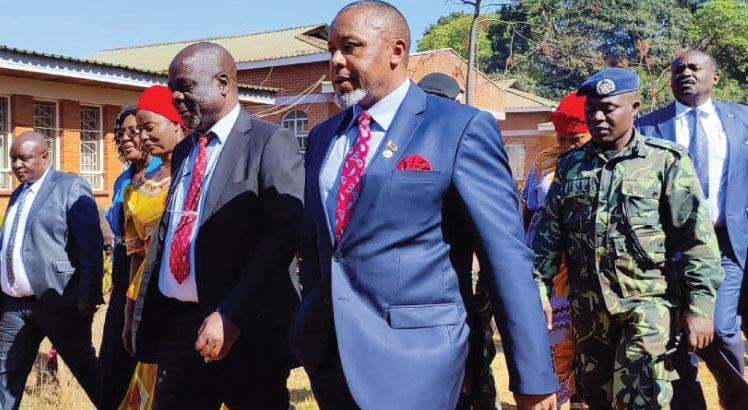Endandweni’s same old cry

The school in hard-to-reach parts of Mzimba in the Northern Region of Malawi, has become a death trap, a crumbling monument of falling investment in quality education for all by next year. JAMES CHAVULA writes.
On a rainy Thursday morning, the first thing that welcomes visitors to Endandweni Primary School is about 60 children learning in a bushy woodlot. In front of the Standard Two pupils sitting on the wet ground is Winston Msiska, the head teacher who is getting sick and tired of such scenes.
“Here, the shortage of classrooms is getting out of hand,” says Msiska of the sight which always brings to mind how a tree killed two children and injured scores at a school near Capital Hill in Lilongwe 11 years ago.
Truly, teachers and learners are being forced into dangerous spaces since the rural school in Traditional Authority (T/A) Mabulabo in Mzimba has only four classrooms for eight classes.
This is not new. Lack of proper teaching and learning space is a well-documented problem since numbers of pupils started bulging due to the introduction of free primary education in 1994. At worst, it is forcing pupils to have lessons in risky tree shades.
However, failure to adequately invest in creating a safe and favourable learning environment resulted in the tragedy in 2003 when a tree crashed the pupils at Nkomachi Primary School in Lilongwe, where all government decisions and budgets are made.
During the week of mourning, consensus seemed to emerge that the country cannot continue to lose its future leaders in this reckless manner. Even then president Bakili Muluzi and other policymakers acknowledged that there was need for greater investment in secure and motivating classrooms if the country was serious about its young citizen’s right to education.
But it appears the consensus, a requisite for the [quality] Education for All (EFA) goals which Malawi ratified in 2000, has not reached Mzimba a year before their deadline next year.
In the vastness of the district, dilapidated Endandweni Primary School is a reminder that government still needs to do more and act faster to end the perilous outdoor classes.
Every day is potentially a bad day.
When it rains, the pupils seek refuge in the nearest block, built by the Malawi Social Action Fund nearly 10 years ago. It leaks and its floor is cracking, leaving a map of underdevelopment in the rural setting. The windows are yawning, exposing both learners and teachers to harsh weather, dust and other distractions.
For students of education administration, this is a good example of what not to do when striving for academic excellence.
Locals remember that the leaky iron sheets of the block were blown off by a storm in 2009, but they waited for renovations until last year when it was fixed by a villager who could not stomach sights of pupils in tree shades anymore.
Now they are banking on Globe Metals Limited, the firm exploring the possibilities of extracting niobium, uranium and zircon at Kanyika near the school, to renovate the blocks and build new ones.
But its proximity to the multimillion dollar extractive project is not the reason authorities should worry about children of unknowns languishing at a small rural school in the interiors of the Ngoni Kingdom. Rather, the 646 pupils risking their lives to access education and increases their chances in life are.
Apart from the outdoor class feeling half a leaking roof is better than none, there is another nesting under a tree behind a roofless four-roomed block which was built in the 1970s and blown about 15 years ago, according to locals.
The M’mbelwa District Council, which reigns over Mzimba, slowly started renovating it this year to ease the scramble for learning and teaching space. But district commissioner, the Reverend Moses Chimphepo, says what the school needs are new classroom blocks, not renovations.
“This is a work for the future considering that the locals have already made bricks, but the council is yet to find funds for the project,” said Chimphepo.
As the wait for funds continues, the pupils’ desperation persists. Behind the monument of delays and misarranged priorities derailing the country’s education system is another class stuffed in an antiquated church.
“Welcome to Standard One and Three,” says long-time teacher Tony Mwape marking a Chichewa exercise for the lower class. The walls of the grass-thatched structure made of sunburnt bricks are slowly being soaked and gullied by water dripping from above. Its leaky roof has been falling in for years.
It is in the vestry of this death trap that Mwape teaches 120 Standard One pupils. On the other end are 92 Standard Four pupils.
What does working in such conditions entail?
“It means teaching at own risk, working knowing the children in front of you will die or get injured if the old building finally collapses” says Mwape.
The long narrow building requires teachers to shout extra hard for the sake of the learner at the back, something Mwape calls “hard labour”.
Unfortunately, there are only six qualified teachers at the school, meaning one for nearly 110 learners. Their workload is almost four times the lofty international requirement of 40 learners per teacher.
The school also has four unqualified teachers, two of them on distance learning and the rest volunteers from its catchment area. The stop-gap stopped short of exacting the government recommended ratio of a teacher for 60 students.
Endandweni is one of the oldest schools built by the Church of Central African Presbyterian (CCAP) and the Reverend Clement Munthali of the area says it is a sign of desperation and negligence that pupils are compacted in the cracked buildings including the church “elders dumped for a new building because it had become hazardous to lives”. The new church has also been colonised by two classes although its roof is incomplete and the floor dusty.
“If pupils come to Endandweni where there is shortage of teachers and classrooms, they will not be motivated to remain and excel in school. No wonder, they are always selected to community day secondary schools where standards are low while their colleagues from neighbouring schools go to boarding schools,” says Munthali.
Nyuma Nhlane’s four children learn at the school. As a parent, she says her main concerned is their safety and chances in life.
“If I had money, I could have enrolled them at a private school, but I have no choice but to risk their lives because they have a right to education,” says Nhlane, 29.






very sad